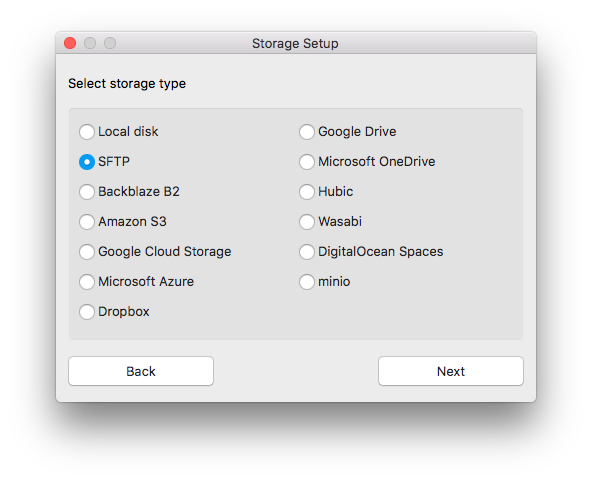Oct 14, 2019
Backblaze B2 Cloud Storage
Backblaze is a company offering unlimited online backup services. In June 2016, they launched the official version of Backblaze B2 Cloud Storage, a metered object storage service. Backblaze B2 Cloud Storage is characterized by price, it is the lowest price compared to other object storage services like Amazon S3 (Cloud Storage Comparison). Just by registering your email address, you can use 10GB free service with no time limit. If you use more than 10GB you will need to register your payment information, but you can continue to use the first 10GB free.
Christie's International Real Estate in Amsterdam, North Holland represented by Pieter Joep van den Brink of Residence 365 B.V. With modern storage furniture, you can keep an organized home without sacrificing style. Sliding doors and cord cutouts make for chic media consoles in the living room by keeping all eyes on the TV instead of the tech clutter. Stock inner cabinet shelves with spare blankets, cords and electronics, and accent the surfaces of consoles with potted.
You have two choices to back up your files to Backblaze. The first one is Backblaze B2 Cloud Storage with a backup application like qBackup. The second one is Backblaze Unlimited Backup. Each has its own characteristics, which one is better to choose depends on the situation. Refer to the table below.
| Backblaze B2 Cloud Storage with qBackup | Backblaze Unlimited Backup | |
|---|---|---|
| Trial | 10GB Free with no time limit | 15-day free |
| Storage Pricing | $0.005/1GB/month (*1) | $5/month (per computer) |
| Backup Application | qBackup (Windows/Mac/Linux) | Backblaze Client Software (Windows/Mac) |
| Restoring | Directly restore files/folders from qBackup | Freespace 2 iso. Restore from Backblaze website |
| Backup Exclusions | - | NAS, Time Machine, etc. |
| File Versions | No limitation | Up to 30 days |
(*1) Additional fee may be charged for downloading and transactions.
qBackup is listed on the Backblaze B2 Integrations. This page introduces how to backup to Backblaze B2 Cloud Storage using qBackup.

Sign up for Backblaze B2 Cloud Storage

Go to Backblaze B2 Cloud Storage, enter your email address and password, and click [Sign Up for B2].
Resep nasi goreng hongkong blue band. Select [App Keys] from the B2 Cloud Storage menu.
Your keyID is displayed on this page. Click [Create New Master Application Key] to create an Application Key.
qBackup uses the keyID and the Application Key to access Backblaze B2 Cloud Storage.

B2 Storage Calculator
Installing qBackup
Download qBackup installer, and run the installer and complete the installation according to the instruction.
Creating project (backup configuration)
Run qBackup, and click [New] on the toolbar.
Enter project name.
Adding backup sources
Select [Include], and add files and folders to be backed up.
Backblaze Pricing
Files to be backed up

Any number of files and folders can be added.
You can add and delete files after backup is executed.
You can specify exclusions on [Exclude].
Storage
Select [Storage] and set storage information.
| Field | Description |
|---|---|
| Storage type | Backblaze B2 Cloud Storage |
| Key ID | The keyID confirmed on Backblaze website |
| Application Key | The Application Key created on Backblaze website |
| Bucket name | The bucket name must be unique for the entire Backblaze B2 Cloud Storage. qBackup creates a bucket if it doesn't exist. We recommend that you create a dedicated bucket for qBackup. |
| Prefix | Specify if you want to create a virtual folder in the bucket. The prefix enables you to create multiple backups in the bucket. If the prefix is blank, backup data will be created just beneath a bucket. |
Options
Select [Options] and set each item as necessary. Backup can be executed even in the initial state. Set encryption password if you need to encrypt backup data.
Uploading speed
If the uploading speed is slow, you may be able to improve by changing the [Max threads] (Storage).
Click [OK] to save the project.
Backing up
Select the project you created. Click [Backup] on the toolbar to start backup.
The processing status is displayed on the window during backup.
When the backup is completed, the processing status becomes [Complete].
Adaalat episode 103. For the second and subsequent backups, only changes from the previous backup are backed up (incremental backup).
Restoring backed up files
Select the backup you want to restore and click [Storage] on the toolbar.
The files backed up in the storage are displayed.

Select the files/folders you want to restore and click [Restore].
Find files to be restored
By double-clicking a folder, you can move into the folder.B2 Storage
On the window that appears, enter conditions such as the destination and click [OK].
The processing status is displayed as in the case of backup.
For more information please refer to the documentation of qBackup and Backblaze B2 Cloud Storage.
Overview ¶
This document describes the storage locations available in Comet. The information applies to both (A) configuring a data storage location in Comet Server, and (B) configuring a Storage Vault location for a Comet Backup user (either locally in the Comet desktop client, or remotely via the Comet Server web interface).
There is a unified storage model across both Comet Server and the Comet Backup client. This means that you can use any of the supported storage locations as a data location for a Storage Role Comet Server; or, you can configure a Storage Vault in Comet Backup to enable backing up to any of the supported storage locations.
The former allows you to leverage cloud resources while still providing a completely opaque front to your customers. The latter may be more efficient and avoids double-handling the bandwidth.
Virtual storage locations ¶
As well as physical storage locations (e.g. local disk, an SFTP server, or Amazon S3), Comet also has a number of virtual storage locations available. These virtual storage locations may combine aspects of physical storage locations in order to offer additional features.
B2 Storage Room Toad
Utilizing Cloud Storage with Comet ¶
Comet supports any S3-compatible cloud storage provider. The cloud storage provider can be configured at the Comet Server level, or at the client level. It is recommended to setup cloud storage at the client level for better performance.
Utilizing cloud storage at the client level (direct-to-cloud) ¶
The backup data will go directly from the desktop client to the cloud storage provider. The cloud storage credentials will be exposed; even though the information is hidden in the Comet Backup client GUI, the customer could still discover it by network analysis or with a software debugger.
It's possible to use the direct-to-cloud method as a requestable Storage Vault. This means that you only have to setup your cloud provider details once, and then request Storage Vaults when required. Comet will manage the data within the cloud provider's bucket, and generate unique sub-directory level access keys per Storage Vault to minimize the impact this could have if the credentials are acquired.
Direct-to-cloud also applies for custom Storage Vaults; ensure credentials are exclusive to the user, i.e. generated per-user credentials with separate buckets.
Utilizing cloud storage at the Comet Server level¶
The backup data will pass through the Comet Server first and then the server will upload the data to the cloud storage provider (in memory). Cloud storage credentials won't be exposed to the client using this method. If your Comet Server is hosted in the same region as the cloud storage account, this may or may not have zero-rated bandwidth cost.
This method can be configured at the Storage Role location in your Comet Server's setup wizard. When setting up a Storage Vault for an account, simply assign it a requestable Storage Vault. Your Comet Server will automatically create subdirectories to store the data for each new Storage Vault.
When using cloud storage in Comet Server as the Storage Role, the upload stream is proxied through to the cloud storage account (if possible), or buffered in memory. No data touches the local disk (no IOPS penalty). However, under memory pressure, the operating system may write to the swap file in proportion to the transfer load.
